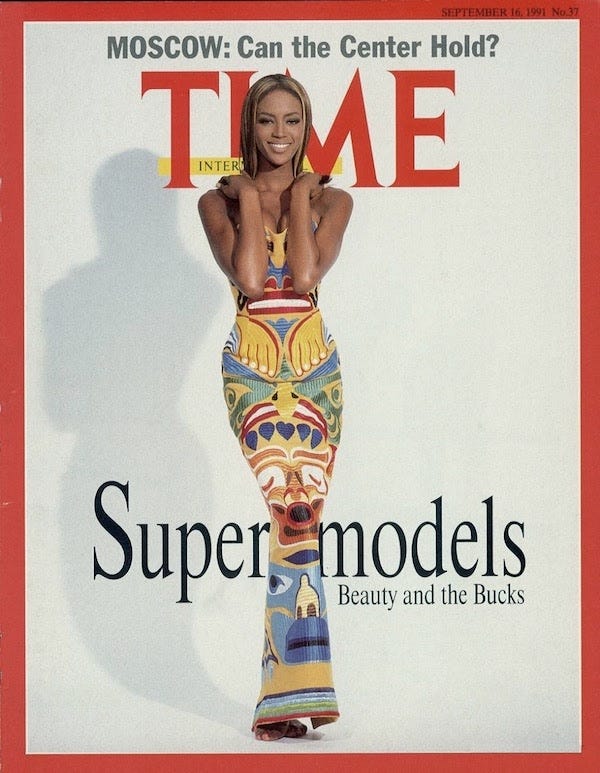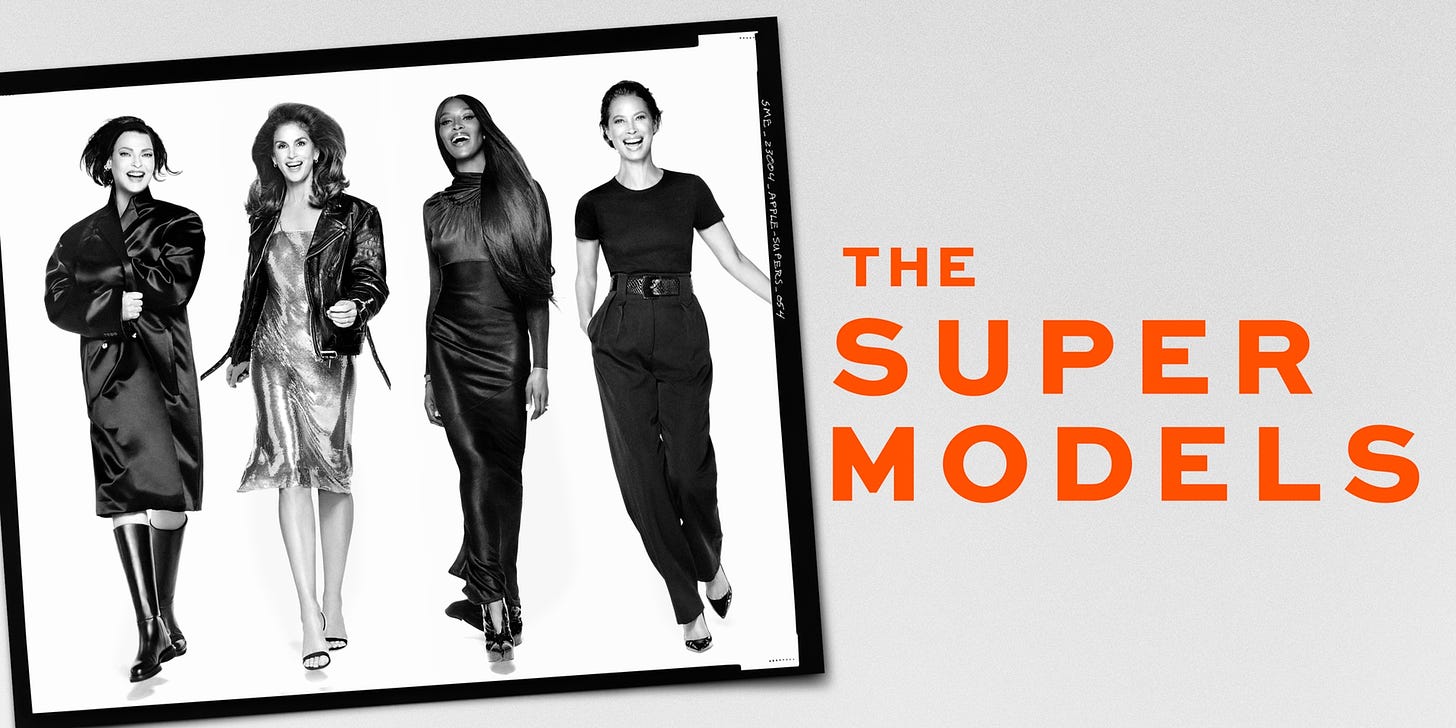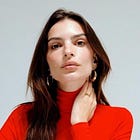Unlike That Vogue Cover, Apple's 'Super Models' Series Delivers
A great watch, even if it could have gone deeper.
“In the same month that communism collapsed, Naomi got the cover of Time,” says a voiceover in the new Apple TV+ documentary series The Super Models, which traces the rise of Naomi, Cindy, Christy, and Linda.
The show contains ample illustrations of the mega-heights to which these women climbed — heights to which, after Gisele, few if any models ever came close to reaching. When MTV wanted a host for a fashion show in the late eighties, they hired not an actress or pop star, but Cindy Crawford. When Calvin Klein wanted a face for its Eternity fragrance — a $1 million annual contract for 100 days of work — they looked, again, not to actors or pop stars, but to Christy Turlington. When George Michael didn’t want to star in his own music video for “Freedom! ‘90,” he cast the supers.
Back Row is a reader-funded publication. If you value the independent journalism you read here, the best way to support it is by becoming a paid subscriber.
The supers were so hounded by the press at their peak that, Linda said, “It was insane. Like, we’re not the Beatles.” She got so tired of being stalked by paparazzi backstage that she hired a bodyguard and bought a can of spray paint, which she threatened to wield on camera lenses if photographers tried to snap pictures of her changing after shows.
This period, when fashion models were the biggest names in pop culture, was dazzling to revisit. The Super Models includes incredible archival footage of the women doing television appearances, signings, photo shoots, and fashion shows. The tremendous assemblage of vintage fashion photography shown throughout the four episodes will make anyone who ever read a paper magazine long for the days when image-making was a serious craft instead of something so casual that the barriers to entry now are simply a smartphone and the will to self-promote.
But what was it that made them — Cindy, Naomi, Linda, and Christy — “super” and not just “models”? Why did these specific women rise to such a pinnacle of fame and success, albeit fleeting?
The Super Models takes many stabs at answering that question:
“She has presence,” John Galliano says of Naomi. “It’s like a magnet.”
“It wasn’t about the fashion,” says Cindy. “It was about the women. That’s what a super model is.”
“The world was thirsty for beauty and glamour and fashion,” says Edward Enninful.
“They weren’t just beautiful,” adds Donatella Versace, sitting on a couch that now lives rent-free in my head. “They became household names, and I think that really solidified the super model.”
This is a fashion documentary series, so platitudes are frequent, the way they are in many fashion conversations. Knee-jerk adoration — “stunning!” “I’m dead!” “slay!” — or rejection — “derivative!” “dated!” — are the pulse of this industry. Some people and shoes/bags/jackets are major simply because fashion people agree that they are and then disseminate that taste to the masses.
That partly explains the supers’ success, but the series leaves the viewer to figure out what made these women not just successful, but generational talents. Part of it was that, as was too-often pointed out, they were a group — a squad before anyone called it that, and fame feeds off fame (see: Kylie and Timothée, Taylor Swift and her friends, the Kardashian-Jenners, and on and on). Also, they aren’t nepo babies like some of today’s top models — none of them came from great wealth or had any connection to the fashion industry, which makes their stories all the more extraordinary. Cindy worked in a cornfield in Illinois before she became a model in Chicago. Linda worked in a convenient store in Ontario and saved some of her wages to buy fashion magazines. Naomi grew up with a single mother in London and traveled by herself to do her first big photo shoot on a slave plantation in New Orleans. Christy was a babysitter and cleaned horse stalls before she was scouted at a stable and starting modeling at 14 years old, only to book a bridal ad at 15.
Back Row is a reader-funded publication. If you value the independent journalism you read here, the best way to support it is by becoming a paid subscriber.
They all went to New York young and speak obliquely about working pretty much constantly in those early days. I would have loved to know what kinds of schedules they had to keep and how it felt, physically. Gisele talked in her book Lessons about how she worked 360 days a year when she was starting out. “He really pushed me to work so much,” said Linda of her agent, Gérald Marie, whom she married at 22 (he was 37) and divorced at 27. Another agent is quoted saying that they all worked very hard, but it’s hard to grasp what kind of endurance these careers required.
I suspect these women are great business people, their own Kris Jenners, but we don’t get that much detail on how they strategized around growing their careers and managing their images. There is a line about how “agents work for you,” which is something that a lot of people who employ agents forget. Cindy talks about how she turned a Playboy cover spread, which she was advised not to do, into a way to broaden her audience from women to both women and men, which made her a desirable candidate to host House of Style despite having no similar prior experience. She talked about stepping out of the fashion world to do ads for Pepsi and beauty brands, explaining, “As a model, a cosmetics contract is the golden ticket.”
Overall, I loved the show — it’s well-paced, a ton of work clearly went into digging up archival media, and hearing the supers talk about themselves and each other is often engrossing, to say nothing of the fashion people commenting on a bygone era. I could watch fashion editor Carlyne Cerf de Dudzeele describe traffic patterns for hours in her French accent with her gesticulations, to say nothing of fashion magazines in the eighties: “Bazaar have a style, Vogue have a style, Elle have a style.” She throws up her hands: “I don’t know how to describe dees!”
Issues that entered the zeitgeist only in more recent years are addressed, if briefly. Linda tears up discussing her “abusive” relationship with her ex, Gérald Marie. “He knew not to touch my face,” she said. (French prosecutors investigated Marie for rape and sexual assault after 15 women came forward, including models Carré Otis and Karen Mulder, but closed the case citing the statute of limitations; Marie has denied wrongdoing.) Christy describes being coerced into posing topless for the late Patrick Demarchelier, who later used the image on the cover of Photo magazine without her permission, but nothing much is said about a model’s agency over her image. The truth is that models often don’t have agency over their image, as Emily Ratajkowski explained in her essay collection My Body, in which she recalled a photographer turning his archive of nude photos of her into a book without her permission.
Though we’re told again and again that the supers had “power,” it’s unclear if it was just in a vague cultural sense or a true business and legal sense. We revisit an uncomfortable Oprah segment where Cindy appeared with her agent John Casablancas, who does the talking while Oprah tells her to stand up to show her body to the audience. “That was so not OK,” Cindy remarks today.
Yet the biggest unanswered question of all may be why fashion has produced so few household names since the supers? Particularly since it’s so nostalgic for the period when Christy, Cindy, Naomi, and Linda were at their peak that they’re not only headlining Vogue events and covering the magazine, but also the subjects of this series?
Back Row is a reader-funded publication. If you value the independent journalism you read here, the best way to support it is by becoming a paid subscriber.
I wish the documentary probed these women deeper on a few other points. Fine, Cindy isn’t likely to talk about nepotism because her daughter Kaia Gerber is a nepo baby (but a great model all the same). But have she or the others thought about how being valued so highly for their looks really affected their self-image, particularly when they started work at age 14? She comes closest to answering this question when she plugs her furniture line, Cindy Crawford Home, saying she likes doing it because “it’s not dependent on her not having a wrinkle or not getting old.” Linda briefly discusses how she decided to do Coolsculpting because she wanted to like what she saw in the mirror. Having been left disfigured by the procedure, she confesses, “I can’t like myself with these hard masses and protrusions sticking out of my body.”
Naomi’s story notably leaves out some of the biggest legal troubles of her career. She blames addiction for her anger issues, and the most we get on her multiple assault convictions is a screen grab of a headline that reads, “Naomi Campbell Charged with Assault.” Then we cut to Galliano saying, “She brought me huge joy when I was in a place that was so dark.” (She arranged for him to go to rehab in Arizona.)
The supers are all credited as executive producers on the series, so this isn’t a hard-hitting work of journalism. Still, it’s a compelling retrospective, and there’s plenty to admire and enjoy about them as fashion icons and characters in this show, which exceeded my expectations. Watch it if you think you want to, watch it if you think you don’t. I bet you’ll like it.
And hey, maybe Galliano really didn’t give better quotes than, “They’re super in more ways than they’re real.”









Did you see the Brooke Shields' doc "Pretty Baby"? I didn't but hearing her promoting the project in interviews it does seem that she delves into how being valued for one's looks when they're a teen (or preteen I think in her case) really had a damaging effect ...
I feel like for a brief moment, Vogue tried to crown a new class of "supers": they called Kendall Jenner and Gigi and Bella Hadid that. But it really didn't seem to stick. Kendall isn't as culturally ubiquitous as her sisters. Gigi and Bella are popular but not in the way Christy and especially Cindy were ...
Thank you for another great piece! Your reflection about what made Supers deserves to be explored. One thing I believe contributed to catapult them to where they are today is their relationship with the designers they catwalked for. Nowadays this type of relationship doesn't seem to exist or be as strong. Designers barely stays 5 years in the same house, or when they build their own brand there are too many middlemen between the designer and the models to create a strong bond, unless you're Gigi Hadid. There is no muse anymore like there were once. Outside of the Supers, when we think of designers like Yves Saint-Laurent, he had 'his' models, he designed FOR them and it led to create a certain image of the brand and the type of woman wearing it. Nowadays, it barely happens.
The whole modelling industry has evolved since the Supers era and now models are even more anonymous than they already were, even with social media. There are faces we know and see over and over again on catwalks, besides the Gigis and the Kendalls of this world, but they just stay, faces. That's it. To be culturally relevant and become a Super, I believe models nowadays can't only model, they'd need to be on many forefronts, and that requires a lot of work, energy, and time. And modelling already sucks up a lot of energy and time.